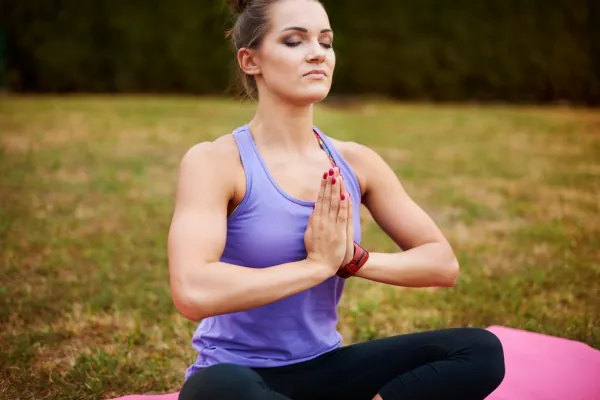Table of Contents
Stress is our response to any mental, physical, and emotional change. Everyone experiences Stress at some point in life, but how we react to change creates remarkable changes in our lives. Once you concentrate on breathing, you take control of your reaction.
If we aren’t responding to change appropriately, it may lead to Headaches, heart diseases, and hair fall. So, we need to handle the situation wisely. You can get relief from Stress by concentrating on breathing. Focusing on breathing changes how you react to the change, whether emotional, physical, or mental. Chronic Stress leads to a negative mental, mood, and digestive system. So, it needs under concentration.
If you are experiencing Stress, headaches, a lack of interest in work, or even irritability, keep reading the article.
How do you concentrate on breathing?

Concentrating on breathing to overcome Stress is scientifically proven, and thousands of studies show how breathing leads to stress relief. Almost everyone knows that, but no one talks about how we can concentrate on our breathing. There are different breathing techniques, which we will discuss in the article, but for each breathing exercise, you will need a peaceful place to practice breathing. It can be your garden, bed, or even your office. Concentrating on Breathing helps you to relieve stress and gain peace.
Types of breathing to overcome Stress:
2.1 Breathing: Technique and Benefits of concentrating on breathing
Technique:
- Sit or lie down comfortably.
- Inhale deeply through your nose for 4-5 seconds, allowing your abdomen to expand.
- Exhale slowly through your mouth for 6-7 seconds.
- Repeat for a few minutes.

2.2 Diaphragmatic Breathing: How to Practice and Its Advantages:
Benefits: Reduces Stress, slows the stress rate, and promotes relaxation.
How to Practice: Place one hand on your chest and the other on your abdomen. Inhale deeply through your nose, focusing on expanding your abdomen rather than your chest. Exhale slowly through your mouth.
Advantages: Enhances lung capacity, improves oxygenation, and promotes calm by engaging the diaphragm.

2.3 Box Breathing: Step-by-Step Guide and How It Helps with Stress:
Step-by-Step:
- Inhale through your nose for 4 seconds.
- Hold your breath for 4 seconds.
- Exhale slowly through your mouth for 4 seconds.
- Hold again for 4 seconds.
- Repeat this cycle for a few minutes.
- How It Helps: Regulates breath, calms the nervous system, and reduces Stress and Stress.

2.4 Alternate Nostril Breathing: Method and Impact on Relaxation:
Method:
Impact: Balances the nervous system, enhances mental clarity, and promotes relaxation.
Use your right thumb to close off your right nostril.
Inhale deeply through your left nostril.
Close your left nostril with your correct ring finger, and release your right nostril.
Exhale through your right nostril.
Inhale through the right nostril, then close it with your thumb.
Release your left nostril and exhale through it.
Repeat for a few minutes.

3. Overcoming Common Challenges:
As an experienced breathing and meditation trainer, I encountered many challenges once we started concentrating on breathing. The most common changes are below, with a Tip to overcome that challenge:

- Not being able to refocus on breathing: While beginners, even a few experienced people, find it hard to reconnect with breathing, that is normal. We don’t need to force ourselves; gently try to shift our focus.
- Sitting for a long time in the same position can be tricky. If you find sitting in the desired position difficult, try other breathing techniques that work for your body. Being gentle to yourself is the first step to breathing.
- If you find any other challenges, you can mention them in the comment section.
Conclusion:
In summary, concentrating on your breathing offers a robust, scientifically-backed method for alleviating Stress. By supporting techniques such as deep breathing, diaphragmatic breathing, box breathing, and alternate nostril breathing, you can effectively manage and mitigate the impacts of Stress on your emotional and physical well-being. Each method provides unique benefits—from reducing heart rate and promoting relaxation to balancing the nervous system and enhancing mental clarity.

Incorporating these breathing exercises into your daily routine doesn’t require extensive time or special equipment. Whether you practice in a peaceful corner of your home, office, or garden, find a method that resonates with you and fits seamlessly into your lifestyle. As with any new habit, consistency is crucial. By making breathing exercises a regular part of your day, you can build resilience against Stress and lead a more balanced and harmonious life.
Remember, managing Stress is stressful, and developing a routine that works for you is essential. Embrace the process, be patient with yourself, and acknowledge the positive changes that consistent practice can bring. Taking control of your Stress through stress-focused breathing improves your immediate well-being and contributes to long-term mental and physical health.
If you want to read more about the Topic, you can read similar articles
The Ultimate Guide 1 best breathing exercise for inner peace
3 Steps to meditate: ultimate guide for beginners
What Are the Best Meditation Positions 3 reasons Why Meditation Poses Matter

